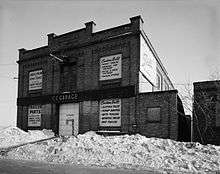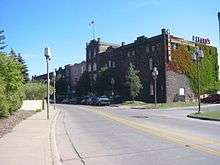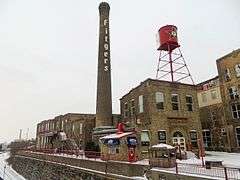Fitger Brewing Company
|
Fitger's Brewing Company | |
|
The complex in Duluth in 2016 | |
  | |
| Location | Duluth, Minnesota |
|---|---|
| Coordinates | 46°47′32″N 92°5′25.5″W / 46.79222°N 92.090417°WCoordinates: 46°47′32″N 92°5′25.5″W / 46.79222°N 92.090417°W |
| Built | 1886 |
| Architect | Multiple |
| Architectural style | Romanesque |
| NRHP Reference # | 84001690[1] |
| Added to NRHP | February 9, 1984 |
The Fitger's Brewing Company brewed beer from 1881 to 1972, making it Duluth's oldest continually-operating industry. The brewery was located at 600 East Superior Street, on Lake Superior in the U.S. state of Minnesota. The complex included ten buildings including the garage/stable (shown), which was built in 1911. Over the life of the company this building housed the horses and vehicle used to deliver the brewery's product.[2][3]
The beginning
The first brewery in Duluth, Minnesota was started by Sidney Luce in 1857, a block and a half from the present day Fitger's site. As the brewery grew, it was purchased in 1881 by Michael Fink, who moved the location to Superior Street, the present day site of Fitger's. Construction of the new building began September 19, 1881. Fink named the brewery Fink's Lake Superior Brewery. The brewery was completed in 1882 and included offices, sleeping quarters for employees, the facilities needed to brew beer, and its own drinking establishment called the Brewery Saloon. Lake Superior Brewery sold its first beer in August 1882. The brewery was very successful from the beginning and sold beer as far west as Aitkin, Minnesota and as far east as Thunder Bay, Ontario.
On November 11, 1882, Fink hired a young German brewmaster named August Fitger. He was a graduate from a premier German brewing school, Weihenstephan Brewing School in Munich (now part of Technical University of Munich, still the most prestigious technical university in Germany, home of many Nobel laureates, and the German equivalent of the MIT). Less than a year after he was hired, Fitger purchased half of the brewing company in April 1883 for $18,000. It was agreed that the other half would be purchased by Percy Anneke, a native of Milwaukee and auditor and sales rep for Schlitz. Anneke was a friend of Fitger, and son of famous German-American political activist, abolitionist and feminist Mathilde Anneke and her husband Colonel Fritz Anneke. The company was renamed A. Fitger & Co./ Lake Superior Brewery.
Prohibition
Beer production continued for forty years until Prohibition began in 1920, forcing breweries to close their doors or change production. Luckily Fitger's was able to find demanded products other than beer to produce, and was one of the few brewers in the entire country that remained open throughout Prohibition. Fitger and Anneke sold their shares and retired in California. Percy's son Victor H Anneke, who had taken over from his father in 1920, wanted to keep as many employees as possible working at Fitger's, but the beer product sales alone could not justify the employment level. In order to keep employees, he decided to get into soft drink and candy manufacturing, and cigar distributing. Fitger and Anneke had set out a strategy several years prior in order to keep the brewery open during Prohibition, which they only expected to last a short time. The company produced five cent candy bars such as The King Bee Nougat, the Flapper, the Spark Plug, the Nut Goodie, and the Skookum. Candy sales steadily increased for several years, but did not prove to be profitable for the company.

Fitger's was one of the first breweries to start distributing carbonated soft drinks by the bottle. The soft drinks featured numerous flavors that often changed. Some of the usual flavors included grape, orange, and strawberry, but they also experimented with other flavors such as imitation chocolate milk shake, black calf, black cow, ginger ale, lemon soda, strawberry fizz, and carbonated water. Their experimenting lead them to the production of champagne like beverages such as Extra Dry and Silver Spray. Both of which were immediate successes through mass amounts of advertising.
However the most innovative idea for promoting Silver Spray came not from advertising and sales people but from Victor H. Anneke himself. In September 1927, Anneke opened the Silver Spray Gym at Fitger’s. He converted the building that had replaced the old brewery into a boxing gym, harnessing the popularity of the sport at the time. The Silver Spray Gym was considered high class for its time. The main floor was a boxing arena and the basement was a training facility. Anneke believed the gym would be a benefit to the community and also good publicity for Fitger’s. Many popular boxers visited the gym, making the facility well known, amongst them the German boxing legend Max Schmeling during his first tour of the U.S. in 1928. When prohibition was finally repealed in 1933, the demand for strong Fitger’s beer grew.
From 1933 to 1936, Fitger’s experienced tremendous growth and record sales. Much of the success was due to the company's continual creation of new products and innovative ways to market them. One of the most successful revolutions in the business was the invention of canned beer. Fitger’s became one of the very first companies in the nation and the first brewery in the Midwest to offer canned beer. Once again Fitger’s focused its manufacturing on beer instead of soda pop and other products they sold during prohibition.
World War II and post war
Just when things were going well for the Fitger’s company, World War II began and Fitger’s was once again fighting to stay open. It became extremely difficult to get the supplies needed to keep the brewery going. Many resources ended up being cleaned then reused because of the lack of materials. Yet some good did come from these years, Fitger’s came out with a number of new beers known as “War Beer”, this type of beer was different than most, it was considered watered down due to the fact that ingredients were scarce and labor was shorthanded. Also since workers were limited because of the draft, women were brought in to work in the factory. Fitger’s successfully stayed open during WWII, which was a remarkable accomplishment. Before Prohibition, there were more than 70 breweries in Minnesota and now only 23, with Fitger’s being one of them.
Post-war changes were of course some of the most exciting to say the least. In 1944, the Beerhalter family bought the brewery. Fitger’s was once again back on its feet, and ready to get down to business. Regular beer was back since ingredients and laborers were now available. Along with that, Fitger’s managed to purchase brand new equipment, it was said that Fitger’s beer was now “more pure” bringing in excited customers.
In 1972, Fitger’s received a letter from the State of Minnesota regarding the two significant problems, Minnesota Pollution Control ordered the installation of expensive pollution abatement equipment and that State Highway Department planned to purchase some of Fitger’s property for the possible expansion of I-35. Fitger’s was unable to afford the equipment needed so on September 30, 1972 they closed their doors, ending 115 years of brewing on the shores of Lake Superior.
Fitger's today

Fitger’s was ready to reopen in December 1984, under new ownership. The complex was purchased by a prominent group of Duluth business owners. The new Fitger’s was greeted with fanfare and great interest, but only two years after it was reopened the construction of Interstate 35 negatively affected business. In 1994, Fitger’s-on-the-Lake LLC became the new owners of the complex. Today Fitger's has a brewery and four restaurants, besides other facilities. There is also a museum about the brewery and a self-guided tour of parts of the historic complex.
Notes
- ↑ National Park Service (2007-01-23). "National Register Information System". National Register of Historic Places. National Park Service.
- ↑ Yearby, Jean (1985). "Fitger Brewery Complex". Library of Congress. Retrieved 2007-12-20.
- ↑ Nord, Mary Ann (2003). The National Register of Historic Places in Minnesota. Minnesota Historical Society. ISBN 0-87351-448-3.
References
- Johnson, Clarence "Coopen" (2004) Fitger's The Brewery and Its People
External links
| Wikimedia Commons has media related to Fitger's Brewing Company complex. |
